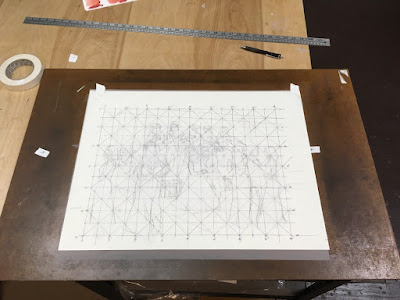Just because I haven't posted any new work of my own in a while doesn't mean I haven't been busy. As noted in previous posts, I'm doing a lot of experimenting. That means a lot of experiments fail and wind up in the trash. But I'm learning a lot, even from the fails (maybe especially from the fails) and trying to build on that.
At some point, though, you have to stop experimenting and produce something. I do, anyway. So there are two paintings underway in the studio right now. They're very different, which is kinda the way I work. One painting is a riff on the artist and model. There's nothing deep or complex there, but I'm trying to apply some lessons learned about putting paint on canvas. That painting went sideways pretty quickly: I tried too many different new ideas, they collided, and I was about ready to slash it with a knife. So I covered up a lot of problem areas with white paint and it's actually much more interesting now. Once the paint dries (white paint takes forEVER to dry), I'll get back to work on it. Maybe you'll see it here someday.
The other painting is much more complex. It's part of my series on what could happen if we keep going the way we're going - a cautionary tale, sorta. It's a wedding, only not like any wedding you've ever seen. That's all I'll say about the painting's subject for now. Instead, I'll talk about the process of putting it together.
I'm using a wedding theme because I've done a lot of wedding paintings for clients and have a ton of reference photos. I've had a strong idea of what I wanted the painting to say, so I did some very rough sketches to get an idea of the basic composition, including the light/dark areas, the initial focus, and what would be needed to flesh out the story. Then I went through my stash of images, pulling out one person from this event, another person from that one, a key item from an entirely unrelated photo shoot, and so on. Then more rough sketches to work through ideas. I'm pretty crappy at using Photoshop, but eventually I put all these different items into one image. Then I did a test painting, essentially a sketch in oil paint, and found some things that worked and others that didn't. More refinement: throw out earlier ideas, bring in new ones, make more sketches.
One question that I know is going to pop up is, if you're using Photoshop, why make sketches? Well, because the Photoshop construction doesn't tell you much. By doing sketches, you see the subtleties of shape, form, light, dark, and subject matter, and you get to understand the total image, and all of its parts, much better.
I also use sketches in an old-school pre-Photoshop way. I draw the environment on a large sheet of paper, then cut out the sketches of people and other items from my sketchbook and tape them down on the large sheet. Then I move them around, put new things in, take other things out and refine the composition. Should this figure be larger? What about perspective? Huh, now I see a line that runs from this woman's arm through that item over there - how to use that? Should I play up this man's face, or play it down? I want a particular effect of light here, so how do I get it? Those are the types of things going through my head.
So, right now, I have worked out the composition for this painting. I have the environment drawn on the large sheet, refined the drawings of the figures as much as they needed, and have them taped down in exactly the right positions. Then I laid a sheet of tracing paper on top and drew a grid on it. It's in the same relative dimension as the canvas is. That's what you're seeing in the photo. I'll draw a similar grid on the canvas, then use light charcoal to copy the composition onto the canvas. And then I'll start painting.
So that's where we are now. Obviously, I still have a loooonnnggg way to go, maybe a month or two or three. And maybe it'll get trashed. But hey, that's life, huh?


